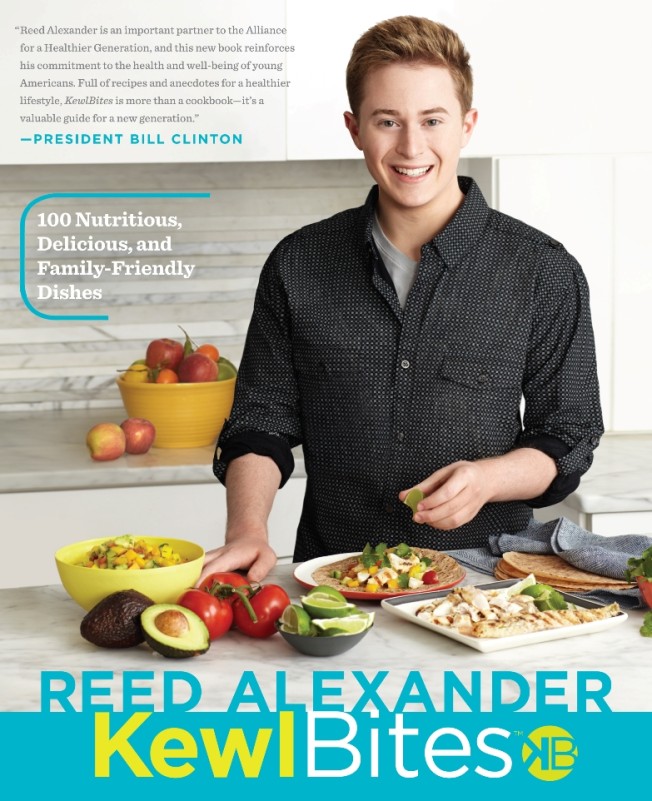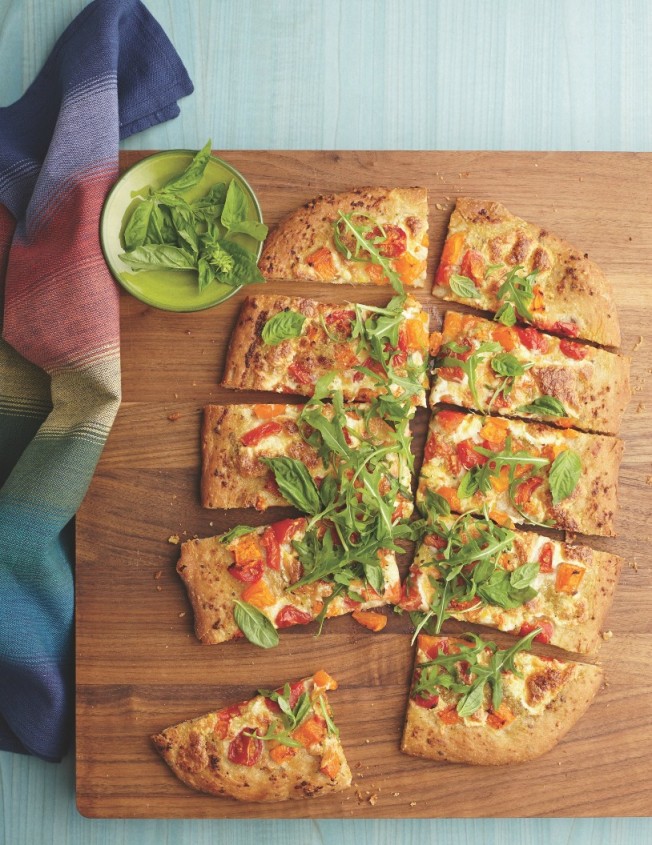You may recognize Reed Alexander as Nevel from the hit TV show iCarly, but these days he has some new projects on his plate. While working as a teen star, Reed’s eating habits suffered, causing him to feel tired and unhealthy. Finally, he decided to make nutrition a priority and turned straight to the kitchen, experimenting with creative ways to turn his favorite foods into meals he could feel good about.
KewlBites.com was born: a web site where Reed shares healthy lifestyle tips and recipes with friends and fans. And now, he’s come out with the new cookbook of the same name, full of a hundred nutritious, family-friendly recipes that don’t skimp on flavor. Lightened-up versions of favorites like fried chicken, pad thai and meatballs make mouthwatering dinners; apple pot pies and oatmeal raisin cookies use ingredients like honey and applesauce for health boosts. Reed also offers tips for eating well during every meal of the day and for stocking a well-rounded pantry.
Here, we ask Reed all about how he revamped his diet, how he develops new recipes, and his go-to recipes from the KewlBites cookbook. We also share the recipe for one of his favorite dishes from the book. Reed will be signing copies of KewlBites in select stores — scroll to the bottom of this post for details!
How did you start cooking and become interested in nutrition? Do you cook with your family, or did anyone teach you?
I’ve always been a major food lover, but several years ago while spending long days on set and regularly criss-crossing the country, I found myself overweight, lethargic, lacking confidence, and needing to make serious changes relating to my nominal exercise and out-of-control eating habits. One of my foremost solutions was to get into the kitchen and turn it into a science lab, breaking out the pots and pans to experiment with recipes and find lighter alternatives for the dishes I love. In doing so, I was completely self-taught. A loss of 15 pounds later, I felt compelled to share what I had learned along the way by launching my website, KewlBites.com. And now, I’m offering families a tangible resource that they can bring into their kitchens: the KewlBites cookbook.
What made you decide to start eating more healthfully?
My family history of diabetes and heart disease was a major factor in spurring me to take health into my own hands. Realizing the intrinsic connection between eating well and feeling your best was another motivator, which inspired me even after I had started instituting healthier habits. Of supreme importance was also the desire to avoid deprivation. I wanted to ensure that I could still savor all of the flavor and deliciousness of my favorite foods, but do so in a better-for-me way.
How did you get the idea to write KewlBites? How do you hope people use the book?
The idea that inspired the creation of the KewlBites cookbook stemmed out of the popularity of my online lifestyle destination, KewlBites.com, a comprehensive resource of tips, strategies, and the 101 on nutrition, fitness, food and more for kids and families. I wanted kids and parents alike to be able to count on a tome of tasty culinary concoctions and advice, like how to stock a pantry with must-have ingredients, grocery store shopping strategies, how to pack a tasty and easy school lunch, and how to cook and plan ahead in order to stay on track. The result: the KewlBites cookbook, a palpable incarnation of my brand that, in the words of the esteemed President Bill Clinton himself when writing an incredible quote about KewlBites, is “a valuable guide for a new generation” — and that’s exactly how I hope that families will see and use the book.
Tell us about the recipes in the book. What’s unique about them?
Each recipe fills a specific need. Some are reinventions of classic family favorites that kids and adults alike love (myself included!) – while others are dreamt up as “edible souvenirs” — the take-aways that I highlight in the book as result of my travels to faraway destinations around the world (cities like Venice, London, Paris and Barcelona). Plus, there are creations that run the gamut from breakfast to dinner, and desserts included, of course, which engage and stimulate cooks of all different levels — from the seasoned baker who has mastered the art of the chocolate soufflé to the kitchen rookie setting about whipping up fresh and vibrant Vietnamese Summer Rolls (the perfect back-to-school lunch!). And of course each recipe includes healthier swaps so that you can indulge without the guilt.
What’s your process for developing a new recipe?
I always approach the development of a new recipe from the perspective of a reader as opposed to a writer. Of course, in writing the instructions to a recipe, I think like an author, but in conceptualizing and testing it, I ask myself questions that a cook in his or her kitchen at home would. I start by putting together a menu of the kinds of foods I’ll cook in a single recipe testing session — I think of them like forays into what I call “kitchen chemistry” — and, while I’m shopping for the ingredients and preparing the dishes that will go into one comprehensive meal, I think about the task at hand with some basic considerations in mind. Will these lamb chops pair well with the quinoa medley from the salad chapter? Are there too many ingredients? Are these recipes accessible? Fast? Will a busy mom or kids just back from a long day at school be able to tackle them? Can they be made in advance or double-batched so you can have them on hand during those jam-packed days? Then, I turn to the best focus group I know — my family — and let their well-honed and perpetually-hungry taste-buds do the talking!
Do you have any tips for creating healthy dishes that also taste great?
Absolutely — I have tons of tips and tricks up my sleeve that can turn any excessive indulgence into a slimmed-down, doable decadence minus the guilt or “splurge” factor. When baking, split white, all-purpose flour with whole-wheat flour, when possible, in order to boost fiber and nutrition, and cut down on the saturated fat from butter and cholesterol from whole eggs by incorporating egg whites, unsweetened applesauce, canola oil and sometimes even peanut butter instead. In savory recipes, replace butter with a light drizzle of olive oil, and increase the volume of your dishes by using green leafy vegetables and fresh produce, as well.
Any advice for other kids who’d like to learn how to cook?
Do it the way I do — one KewlBite at a time! Learning to cook is a step-by-step process, like taking karate; it involves graduating from one echelon to the next until you achieve your black belt. In other words, start with the basics — chopping, sautéing, or baking simple confections like cookies and quick-breads which require very straightforward batters — and then move onto the higher-level techniques like whipping eggs into meringue and searing fish and meats. Most importantly, be bold and creative, cook the foods you love, and make your time in the kitchen upbeat, cathartic, and fun!
What are some tips for making food that kids and teens will love?
I always start at ground level — by planning a theme. Set aside one night a week (weekends — especially Sunday afternoons — are ideal), and invite your kids to go to the grocery store with you, to set the table, and to divide and conquer on the cooking front. For instance, get them excited with something enticing like Movie, Game, or Taco Night, and go from there, planning a menu that everyone will enjoy and dishing out (no pun intended!) a job for each member of your family to tag-team in the kitchen. Your kids will be proud of their newfound culinary prowess and of what they’ve made, whether it be pizza, fajitas, or cookie cake (my Peanut Butter Chocolate Chip Cookie Bars hit the spot!), and will gladly devour every bite.
What does a typical day of eating look like for you (breakfast, lunch and dinner)?
When I’m at home, I start the day in the kitchen, whipping up a batch of my Cherries Jubilee Quinoa or heating up some pre-made whole-wheat Belgian Waffles for an on-the-go breakfast — the most important meal of the day (yes, that old adage is, in fact, true)! Lunch is usually my biggest meal of the day, but is by no means over-the-top, consisting of a protein-packed salad usually starring chicken or shrimp, and lots of other mix-ins. For dinner, fish is typically on the menu (think salmon with brown jasmine rice and wok-sautéed veggies on the side), occasionally followed by a light bite of a sweet treat. However, eating well while on the road is just as crucial, even when you don’t have access to a refrigerator and stovetop. So frequently I make few extra Kewl Krunch Bars — my homemade take on an energy bar— ahead of time before the long journey, and eat powerhouse snacks like trail mix to stay fueled and satisfied.
What dishes from the book do you go to most often?
That’s easy… Well, on second thought, maybe not so easy! It really rotates season by season. However, some of my top go-tos include my Orange French Toast, Oriental Shrimp-Udon Soup, Turkey Burgers with Butternut Squash Fries, Vegetable Dumplings, Apple Pot Pies, and Vanilla Bean Pound Cake.
Tell us about the flatbread pizza recipe we’re sharing – how did you come up with it, and how do you like to serve it? Any other suggestions or favorite variations?
Inspired by the first bite of traditional Italian pizza I savored in Venice, this Flatbread Pizza (one of my all-time favorites!) is an homage to the crispy crust, juicy tomatoes, bracing basil, and overall heavenliness I experienced in a little café overlooking the Adriatic, which forever changed my life — well, at least, my outlook on pizza. A flaky, whole-grain crust is the foundation for my olive oil-garlic-shallot-and-oregano paste which I brush on liberally, followed by multicolored tomatoes, fresh herbs, and creamy mozzarella which are piled on top. Wilted fresh arugula is the pièce de résistance, capping off the perfect pizza. Serve it in the Italian style — with an ice-cold glass of sparkling water on the side and a bite of biscotti for dessert! It’s also delicious with a variety of toppings, such as olives, artichoke hearts, or caramelized onions. I can’t promise that it will whisk you down the canals of Venice or transport you to the Rialto Bridge, but, somehow, with every bite, it always feels like I get pretty close.
Flatbread Pizza
YIELD: 4 servings
This delicious pizza conceals a secret flavor weapon: my shallot-garlic-and-oregano-infused olive oil, which I (generously!) brush over the thin dough before baking to give the crispy crust a golden brown hue. If you’re in a time crunch, buy premade dough–preferably whole grain–at your local pizza parlor or grocery store. Or, on a leisurely weekend afternoon, turn your kitchen into a pizzeria and whip up your own–midair pizza maestro toss and all!
1 pound whole wheat or multigrain pizza dough, at room temperature
1/4 cup olive oil
1 medium shallot, quartered
2 cloves garlic, halved
1 teaspoon dried oregano
1 medium red tomato, sliced into triangular chunks
1 medium yellow tomato, sliced into triangular chunks
8 ounces fresh mozzarella, sliced into large square or triangular chunks
1 cup arugula leaves
1/4 cup fresh basil leaves
Preheat the oven to 475°F. Line a large baking sheet with aluminum foil and coat lightly with olive oil.
Lightly dust a rolling pin and cutting board with flour. Roll the dough out to an even, flat rectangle approximately 14 by 9 inches. Ensure that there are no holes.
In a food processor, combine the oil, shallot, garlic, and oregano and pulse until smooth. Brush the paste liberally over the dough, reserving some for the toppings. Carefully transfer the dough to the baking sheet. Top evenly with the tomatoes and cheese and brush lightly with the remaining paste.
Bake the pizza for 14 minutes, until the dough is puffed and golden and the cheese begins to bubble. Top evenly with the arugula and basil and bake 3 minutes more, until the arugula is wilted and the dough is crispy.
Cut into 10 slices and serve.
*TIP: Boiling leek tops infuses the broth with potent flavors and tenderizes them to the point where they melt in your mouth. “Steeping” the herbs in the liquid is another way to impart strong flavor to the broth.
*TIP: Toasting nuts or seeds is super-simple! It unlocks the deep, nutty flavors of any nut or seed within a matter of minutes. For this salad, spread dry, raw pumpkin seeds on an ungreased baking sheet lined with aluminum foil, then toast in a 325°F oven for 20 to 30 minutes, stirring occasionally. You’ll notice their fragrance beginning to permeate your kitchen, and the seeds will turn golden. Toss them into the salad here or into trail mix, or enjoy a handful on their own, sprinkled with a little sea salt. Pumpkin seeds are rich in key nutrients like zinc, which fortifies your immune system, and magnesium, which contributes to strong bones and teeth.
Stop by, meet Reed, and get him to sign your copy of KewlBites at these store events:
- 9/28, 1 p.m. in Santa Monica, California
- 9/29, 1 p.m. in San Diego, California
- 10/1, 5 p.m. in Walnut Creek, California
- 10/5, 12 p.m. in Boca Raton, Florida
- 10/5, 4:30 p.m. in Miami Beach, Florida
- 10/6, 12 p.m. in Palm Beach Gardens, Florida



3 comments
Hello there! This post could not be written any better!
Reading this post reminds me of my old room mate! He always kept
chatting about this. I will forward this page to him.
Fairly certain he will have a good read. Many
thanks for sharing!
Hi there colleagues, іts fantastic article on tɦe topic oof cultureand еntirely explained,
қeep it up all the time.
Deff going to purchase the cookbook!